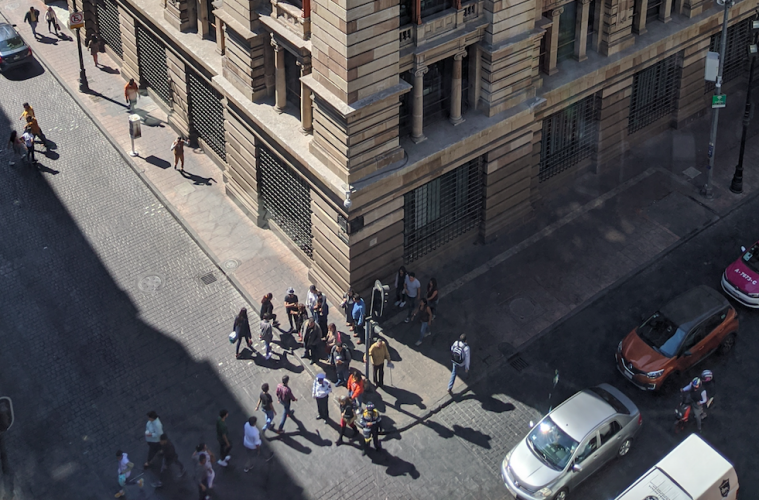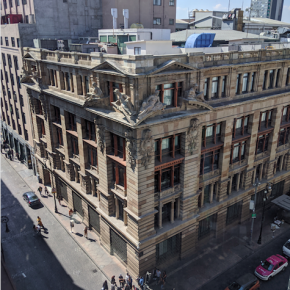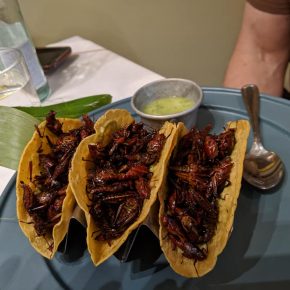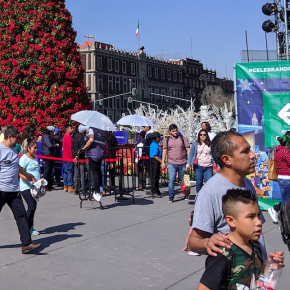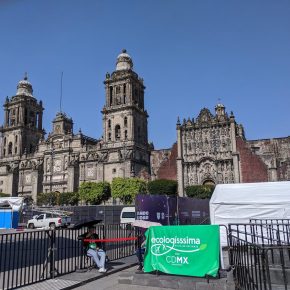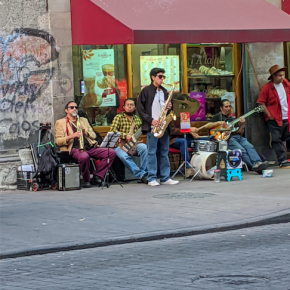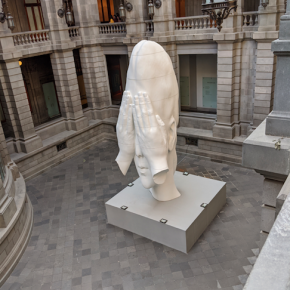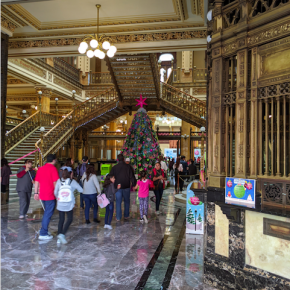My son got married in Mexico. The wedding was celebrated in a hacienda in Jiutepec, Mexico, a suburb of Cuernavaca, a city about an hour and a half (as the van drives) south of Mexico City.
In case you’re thinking of sending well wishes to the happy couple, the wedding was December 28, 2019. It was a beautiful affair. We had a great time. But that’s not what this story is about.
The week before our trip, the U.S. State Department issued a bulletin warning Americans to avoid travel to Mexico. Certain states were highlighted as especially dangerous, including the state of Morelos; capital city, Cuernavaca. Mexico City was on there too. Violent crimes were on the rise, and American tourists’ safety couldn’t be guaranteed. Besides seeing the warnings twice on the Internet, a few friends and relatives emailed me the links.
What, me worry?
Yes actually. Me worry plenty.
It wasn’t only me heading into potential trouble. I was going down there with my wife. My daughter and her boyfriend were meeting us in Mexico City. My son and his (then) fiancée were headed straight to the hacienda in Jiutepec. So were my sister-in-law and brother-in-law with their kids and their kids’ spouses.
So yes, there were moments of stomach-churning worry.
For most of the two weeks before we left I imagined bad neighborhoods, corruption, random crime, drug cartels, and other unpleasantries. I knew there were criminals just waiting to target us during our travels. Either they would spot us as American tourists, or they already knew we were coming, what we were carrying (so they could rob us of it), and the best time and place to accost us because they knew our entire itinerary. Of this, I was absolutely certain.
But then I started questioning the State Department’s warning. This danger they were speaking of – compared to what? South side Chicago? Times Square in the early 1980s? The east side of Ferndale?
I spoke to my son’s fiancée who frequently travels to visit family, sometimes alone, in a small Mexican town. According to her, these warnings were issued regularly. Her advice: be aware of your surroundings, avoid flashy jewelry or big wads of cash, leave valuables at home, and know which neighborhoods to avoid. In other words, use the same common sense you would use when traveling to any big city or foreign country.
Mexico City is a very big city. It is home to over 20 million people, and it is the largest metropolitan area in the Western Hemisphere. There are very few high-rise buildings or skyscrapers, so the city covers a lot of ground. It also is the city with the largest number of museums in the world. (But we only made it to one.)
The journey to Mexico was nothing every traveler hasn’t gone through; reserving a 6 AM Lyft for 6 PM (fortunately noticed and corrected by my wife), ridiculously long security lines in which we were beaten with truncheons to hurry us along, a lengthy search at the Mexico City airport for the driver who was to take us to our Mexico City Airbnb, and then wondering where we were once we got to our destination.
But we made it. Due to scheduling vagaries, my daughter and her boyfriend came in on separate flights later in the day and spent so much time searching for each other their driver left and they had to rent a Uber. It took a while for them to figure out that one of them was in terminal 1, the other in terminal 2.
- Room With A View
- Grasshopper Tacos
- Zocalo
Our Airbnb was in Mexico City’s historic center, a touristy area, but a very cool touristy area. We stayed in a very large sixth floor, two-bedroom apartment. To get to it, we depended on the doorman, who let us in and out of the building, and who took us up and down in a coffin-sized elevator. The four of us and the doorman could squeeze in if we didn’t have any luggage.
We arrived December 24th, but we were assured that there would be restaurants open both Christmas Eve and Christmas Day. And there were. We just had to find them.
Within a block of our temporary abode, there were two full-service restaurants, a bakery, a taqueria, a rotisserie chicken carry out, an ice cream parlor, a pizzeria, and a 7-11.
By dinnertime, our only choice, as we waited for our daughter and boyfriend to find each other and get a ride, was the rotisserie chicken place. It was a lot of other people’s choice too, so I waited in a half-block long, slow-moving line to pick up a couple of chickens, sides, and a two-liter coke.
It was worth the wait. Whatever spices they used on their chickens, they weren’t the same spices we were used to, but they rocked.
We had a lot of great food in Mexico, both in the city and at the Jiutepec hacienda. But I wanted more. I don’t know about you, but over the years I’ve become fascinated with food. I don’t know why. It’s not like I’ve ever been in danger of starving. But I love the varieties of types, tastes, textures, smells, origins, differences, looks, colors, and shapes of food. There are (according to Wikipedia) 15,000 restaurants in Mexico City in addition to the street food, so we had our choices. Three days isn’t much time though, so we weren’t able to sample much, and we never did get to the ice cream.
There were a few tasty things we did have time to eat. One item that turned out to be better than it sounds was the grasshopper taco. There were actually three tacos in the order. I only ate two because I also ordered a plate of fish tacos, and I shared in a salad. My daughter ate the third taco, so it didn’t go to waste.
I was kind of surprised when the order arrived. I had cricket and goat cheese tacos at another place, and although I liked them, they turned out to be lots of goat cheese with a few cricket pieces. These tacos were stacked high with crispy, crunchy grasshoppers. The waiter smiled as he delivered them. I don’t think very many Americans order them.
Eating was not the only thing we did in Mexico City. Although prices were great, and there was a tremendous variety, our stomachs could only hold so much. So after a leisurely breakfast, Christmas Day, we walked to the Zocalo, Mexico City’s historic center, aka its main square.
We weren’t the only ones. The square was packed with residents, tourists, vendors, and street entertainers. There was a Christmas tree. There was even an ice skating rink filled with people who were ice skating as well as one would expect from people living in an equatorial climate. There was a Christmas Mass going on inside the Catedral Metropolitana de Mexico, one of the main attractions on the Zocalo. We tried not to be too intrusive as we wandered around inside with dozens of other tourists, taking photos and looking around in awe.
- Jazz Band
- Museum Bust
- Post Office
The cathedral was built over the former Aztec sacred precinct. Nearby were uncovered ruins of Aztec buildings and a model of what the Aztec city looked like before the arrival of Hernando Cortez and Co. We were walking in the footsteps of the Spanish Conquistadores whose mixture of steel weaponry, gunpowder, old-world diseases, and co-opting of the Aztec’s native enemies allowed fewer than 200 fortune-seeking Spaniards to bring down an empire that ruled millions.
Exploring further, we followed the crowds up a busy street filled with – yep – more tourists, residents, etc., who were out enjoying Christmas Day by shopping, walking, and watching the street entertainers. Not every store was open, but the number of people out walking gave us a “Times Square” feel, without the hassle of New York City hustlers.
We walked all the way to Alameda Central, the oldest public park in the Americas. It was built in 1592, on what used to be an Aztec marketplace, but it was obviously well looked after as it all seemed brand new. There were more street vendors and entertainers; one set of clowns even pulled me into their act, although they had to work around the language barrier. Our last night in the city, my wife did return there to shop among the vendors and got a couple of really nice wool, real Mexican ponchos. There was a Sears close by, but we couldn’t come in.
Next to the park was the Palacio de Bellas Artes, one of the museums that we did not make it to. On the advice of many friends we had planned on going to the Frida Kahlo Museum, but having made no advance plans we were shut out as tickets sell out well in advance. The Diego Rivera murals will also have to be scheduled for a future visit.
The museum that we did make it to was the Museo Nacional de Arte. It featured, strangely enough, a lot of Mexican artists. It held lots of great stuff; paintings and sculptures from the 1600s to the 1900s. It was well worth visiting. We also went into the post office (palacio postal). That may not sound like much, but this particular branch is a tourist attraction in itself having the most beautifully designed interior I’d ever seen in a post office.
Across the street from the museum, with amplifiers cranked loudly enough to be heard within the museum’s walls, was a street band playing very competent “classic rock” tunes. The set we heard (from inside and outside the museum) included Cream, Steppenwolf, ZZ Top, CCR, and The Beatles. Later that evening, a few blocks away, on a more upscale street, there was a jazz band doing justice to Thelonious Monk’s “Well, You Needn’t.” My brother-in-law posted a video on Facebook of some opera singers outside of his family’s hotel. I don’t know much about Mexico City music clubs, but Mexico City’s streets contain quite a variety of musicians.
All along these heavily traveled streets, there is a heavy police presence, a very heavy police presence. And that should have left me feeling secure. The way my mind works though is that all I could see were targets for drug cartel assassins – and pedestrians as collateral damage. Why would the cartels bother? I don’t know, but why shouldn’t I create some mental discomfort to make sure that I limit my enjoyment?
There were two negatives to the trip that I had no hand in creating. The first was the fact that tap water was not safe for drinking. Bottled water was easy to find and it was inexpensive. A liter, outside of hotels and haciendas, was usually 12 pesos (72 cents). And there was a water cooler with a spare five-gallon bottle at the Airbnb. But we were forced into the inconvenience of having to plan in order to make sure that we had drinking water when we went to bed. We all get thirsty at night, and no one wants to run out at 4:00 AM to buy water.
Then there was the traffic. We took a couple of Ubers, and some of the crosstown traffic seemed like a giant game of Chicken. Drivers left a millimeter or two between each other as they moved a few inches or feet at a time when they had the chance. Lane changes were done as soon as they were signaled without worrying if there was a car in the lane one was changing to. Bikers and cyclists, having a size advantage, raced along between lanes. Pedestrians crossed where and when they felt like it. And yet, we made it to where we were going without incident.
Finally, one piece of advice – download Google Translate. It’s amazing. As much as I hate having Google take over one more piece of my life, I was able to communicate in spite of the fact that the number of languages I speak, completely due to my negligence, is one.
My wife and I talked about going back to Mexico. There are things to do in Mexico outside of the cities (and there are over 14,000 Mexico City restaurants that I have not tried). Based on this trip, I have no fear of returning, because let’s face it; as long as one takes proper precautions and doesn’t act like a brainless schmuck, one is probably as safe in Mexico City and Cueranvaca as one is in any other large metropolitan area.

